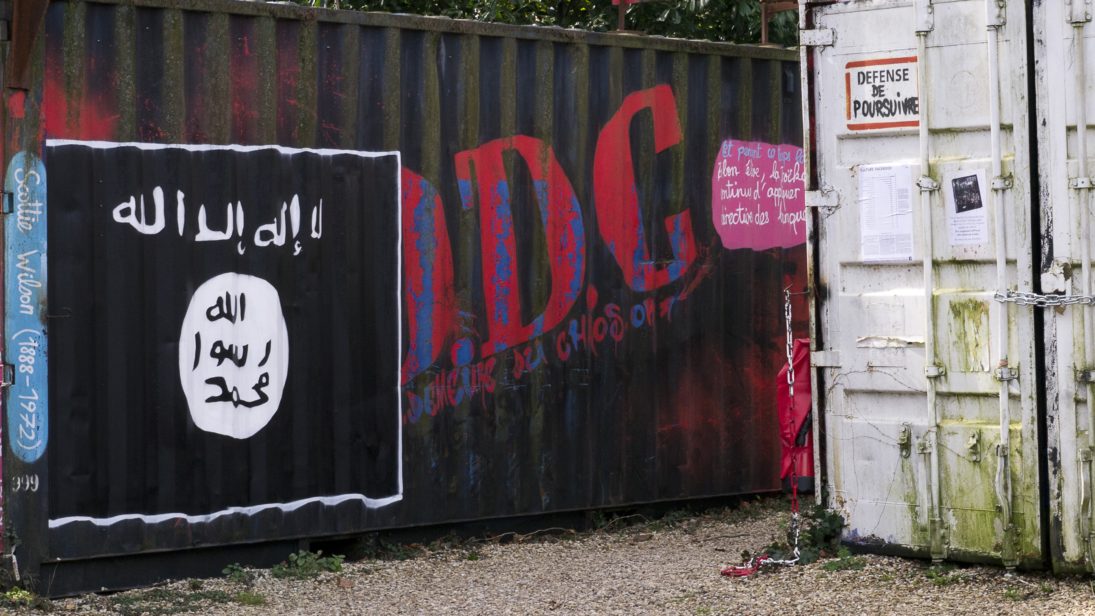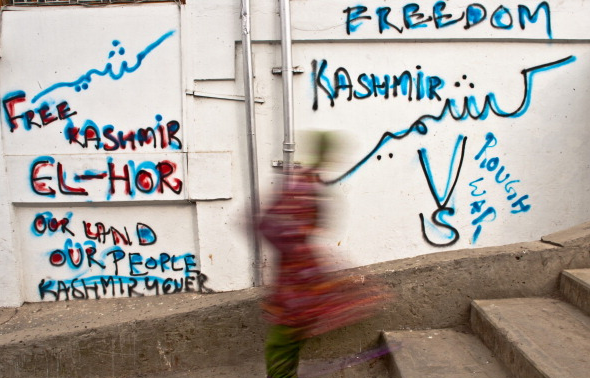
In Indian-administered Kashmir, the three decade-long armed militancy is continuing to inspire youth to take up arms against the state, particularly since the killing of its poster boy Burhan Wani, a Hizbul Mujahideen (HM) commander, in July 2016. His death, and the civilian uprising that followed in which over 100 were killed, has demonstrably led to the strengthening of anti-India sentiments. This new wave of militancy has been marked by reports of a new presence of ideologies under the banner of global Islamic jihadi organizations such as Al-Qaeda and the Islamic State (IS). However, there are no accurate details on what impact IS and Al-Qaeda are having on the ground in Kashmir. Are they simply influencing youth ideologically, or are they beginning to exist as armed outfits?
Traces of IS and Al-Qaeda in the Valley
At first, the only indication of the presence of either IS or Al-Qaeda in Kashmir existed in the waving of black IS flags during protests. In response to these initial reports of such flags being raised by protesters in 2015, Farooq Abdullah, former Chief Minister of Jammu and Kashmir (J&K) and the head of the National Conference party, said it was merely an expression of the “frustration and anger in the youth.” Still, the waving of flags persisted into last year, as pictures of armed rebels with the same flags started going viral all over social media.
Alongside the waving of flags, there have also been troubling reports of militants who have been influenced by the ideologies of IS and Al-Qaeda. On March 12, three armed young boys were shot dead during a gunfight with Indian troops on the outskirts of the state’s summer capital of Srinagar. The slain were identified as 23-year-old Eisa Fazili, Syed Owais Shafi, and Mohmmed Toufeeq. At first, news reports of the encounter made no mention of IS or Al-Qaeda. Fazili and Shafi were said to be associated with two militant outfits that have long maintained a presence in Kashmir—while Toufeeq had travelled from the South Indian state of Telangana to join the militants. However, IS then claimed that Fazili and Shafi were each associated with its cadres in the valley, while Ansar Ghazwat ul Hind (AGH), the local unit of Al-Qaeda, claimed Toufeeq was one of its first recruits. Even the J&K police later said Toufeeq had in fact been “radicalized into Islamic State ideology through social media and went to Kashmir to participate in terrorist activities of ISIS.” The Telangana police confirmed the same.
Prior to these deaths, the propaganda of IS and Al-Qaeda was floating on social media platforms, but there was little evidence of imminent danger in the form of the Islamic State-Jammu and Kashmir (ISJK) and AGH. Only one militant, Mugees Ahmed Mir, was reportedly radicalized by IS’ online propaganda and during his funeral last November his body was wrapped in an IS flag. However, with both IS and AGH claiming its fighters—including one South Indian man—were killed in the same gunfight, analysts have begun to raise the question of whether IS and Al-Qaeda have begun to pose a threat in Kashmir.

Between the Independence Struggle and the Pan-Islamic Movement
After Wani’s death in 2016, the engineer-turned-militant Zakir Musa was promoted to commander of HM, but he soon abandoned this position in July 2017 to form and head AGH. Before forming AGH, Musa set the dangerous precedent of declaring that the ongoing movement in Kashmir is not for the purpose of forming a new nation state. “If you will be a thorn in our way, we will leave the infidels and kill you first,” Musa said in an audio, referring to the Hurriyat leaders who have traditionally represented the anti-India strain of political discourse in Kashmiri politics. He continued, “Kashmir’s war, particularly of the Mujahideen, is only to enforce Shariah. It is an Islamic struggle.”
The materialization of active IS and Al-Qaeda-affiliated sympathizers and militant groups will undoubtedly impact the credibility of the Kashmiri narrative of the ongoing struggle.
The distinction between the Islamic struggle and the freedom struggle in Kashmir again reverberated at the funeral procession of Fazili, whose body was wrapped in a black flag while pro-Musa slogans—along with the normal pro-Pakistan and pro-freedom slogans—were being chanted. Though several observers claimed that a group of young men forced the wrapping of his body in the black flag, Fazili’s ideological devotion to a pan-Islamic worldview and his reasons for becoming a militant in Kashmir were well-known due to a video recording that went viral in September 2017. “I was not fed up with society, worldly affairs or my engineering studies. Only after seeing the abject condition of Muslim Ummah did I choose to tread the path of Jihad in the name of Allah for Allah’s sake,” said Fazili.
The emergence of pan-Islamic perspectives such as those articulated by Fazili and Musa taking hold in the Kashmir valley will likely have political ramifications for J&K. While Kashmiris have been asserting that their ongoing pro-freedom movement is indigenous and bereft of the influence of religious extremism, many within India continue to define the movement as connected to global Islamic terrorism. Thus, the materialization of active IS and Al-Qaeda-affiliated sympathizers and militant groups will undoubtedly impact the credibility of the Kashmiri narrative of the ongoing struggle.
Real Presence in Kashmir?
So far, both the IS and AGH have each only paid tribute to a few slain militants, claimed responsibility for a few small attacks, produced video and audio messages for the public, and boasted of their rise in the Kashmir valley through bulletins shared on social media. Notably, their social media presence also appears to be growing, as evidenced by the flow of messaging in their Telegram channels or other platforms. Still, no picture or video has displayed a high number of armed militants.
However, there is some indication that AGH has succeeded in generating a preliminary base of militants. After the group’s formation in July 2017, there were two high-profile instances in which the senior commanders of Pakistan-supported groups Lashkar-e-Taiba (LeT) and Jaish-e-Mohammad (JeM), Abu Dujana and Abu Hammas, switched their affiliation, adopting the AGH banner instead. In the first week of April this year, four AGH members were arrested in two different raids while trying to buy weapons. These arrests show that Musa is trying to strengthen his group by recruiting more people and attempting to increase his weapons cache. Still, as per government’s estimates, Musa has the support of only ten armed militants.
In contrast to AGH, IS has not shown any real presence in the region, despite an active social media campaign disseminated from its Telegram channel. The group has claimed only two attacks since it announced its intention of extending the Islamic State-Khorasan Province (ISKP), which is primarily based in Afghanistan, into Kashmir in February 2016. The first of these incidents occurred when a policeman guarding a Hurriyat leader in Srinagar was shot and his rifle snatched by gunmen. He later died at the hospital. The IS official news outlet, Amaq News Agency, published a message claiming responsibility for the attack along with pictures of the rifle, calling it the second attack by its cadres. The police claimed that Fazili was responsible for this attack.

However, the two groups have been little divergent in their messaging, with AGH focusing much more on expressing its pan-Islamic ideology. On the one hand, IS has taken the same tone it embodied during the conflict in Iraq and Syria, claiming responsibility for violent attacks and sharing images with their flags and banners. AGH, in comparison, has articulated its vision of jihad that is “not for nationhood or nationalism” and voiced a damning criticism of Pakistan. In one of his messages, Musa says, “My respected and beloved brothers, I am not even the dust of your feet but just an ordinary soldier of Islam.”
Musa’s approach of taking a path against the popular movement has gained him some degree of popularity among youth.
Musa’s approach of taking a path against the popular movement has gained him some degree of popularity among youth. In recent students’ protests in April, slogans hailing Musa were chanted in several parts of the valley. Considering what AGH is representing—a view that could impact the politics of Kashmir’s decades-long movement—his rise as an iconic figure should worry people across the political spectrum.
Political Divisions and Backlash
Those in the Kashmiri political sphere are divided on whether Musa is on the right path or if he is tearing apart the resistance movement. Indeed, some slain militants have begun requesting that pro-Musa slogans not be chanted at their funerals. One militant killed in the April 1st gunfight in Anantnag district had told his parents, “At my funeral, no black flags, only Pakistan’s flag, which is the Islamic flag. Raising slogans of Musa is un-Islamic and whosoever wants to raise it shouldn’t come to my funeral.”
The negative response from the pro-freedom leadership has also been particularly strong. They have called the introduction of these ideologies a conspiracy of Indian agencies. “Terrorism and the freedom movement are poles apart. Our movement is local in nature and indigenous in character,” said a joint statement issued by Hurriyat leaders in July 2017. It said that ISIS and al-Qaeda are “non-existent” in the region and “there is no role for these groups within our movement” but it is New Delhi that is trying to “label it with global terrorism.”
In the context of the socio-political landscape of Kashmir and the backlash AGH and ISJK have already received from pro-freedom leaders and other militants, it is clear the pan-Islamic ideologies of AGH and ISJK run contrary to the self-perceptions of many within the Kashmiri resistance. Indeed, pro-freedom leadership likely views the groups as threats to the indigenous character of their struggle. Similarly, the objectives of other militant groups to one day merge with Pakistan do not coincide with IS’ vision of establishing a caliphate spanning Khorasan Province across Central and South Asia.
Dangers Ahead
If their perceptions begin to influence some Kashmiri youth, IS and Al-Qaeda have the potential to fracture the ongoing political movement in the valley, creating divisions among the political outfits against India or in favor of Pakistan.
While both groups are still nascent, it is clear that ISJK and AGH today exist primarily as ideas rather than armed outfits, and this is likely to remain the case for some time. Nevertheless, their extreme ideologies alone are dangerous for the region’s already-tense political arena. A senior counterinsurgency official in Kashmir told this author in March, “ISIS or Al-Qaeda may not be able to establish a powerful armed force, but the ideologies are growing and the idea itself is dangerous for Kashmir.” If their perceptions begin to influence some Kashmiri youth, IS and Al-Qaeda have the potential to fracture the ongoing political movement in the valley, creating divisions among the political outfits against India or in favor of Pakistan. This could lead to infighting among militant outfits, similar to the mid-1990’s era. Musa’s polarizing rise as a militant icon has foreshadowed the potential for these groups to rip apart the social and political fabric of the valley.
At the core of this issue, however, is Kashmir’s political problem. The very existence of young boys with guns—and those who are sympathetic to them—is an offshoot of the unresolved dispute between India and Pakistan, which today stands far from resolution. The killing of militants is unlikely to find peace, but may lay the foundation for something far more dangerous that could not only tear Kashmir apart, but also threaten peace and stability in South Asia.
***
Click here to read this article in Urdu.
Image 1: thierry ehrmann via Wikimedia Commons (cropped)
Image 2: Tauseef Mustafa via Getty
Image 3: Yawar Nazir via Getty


